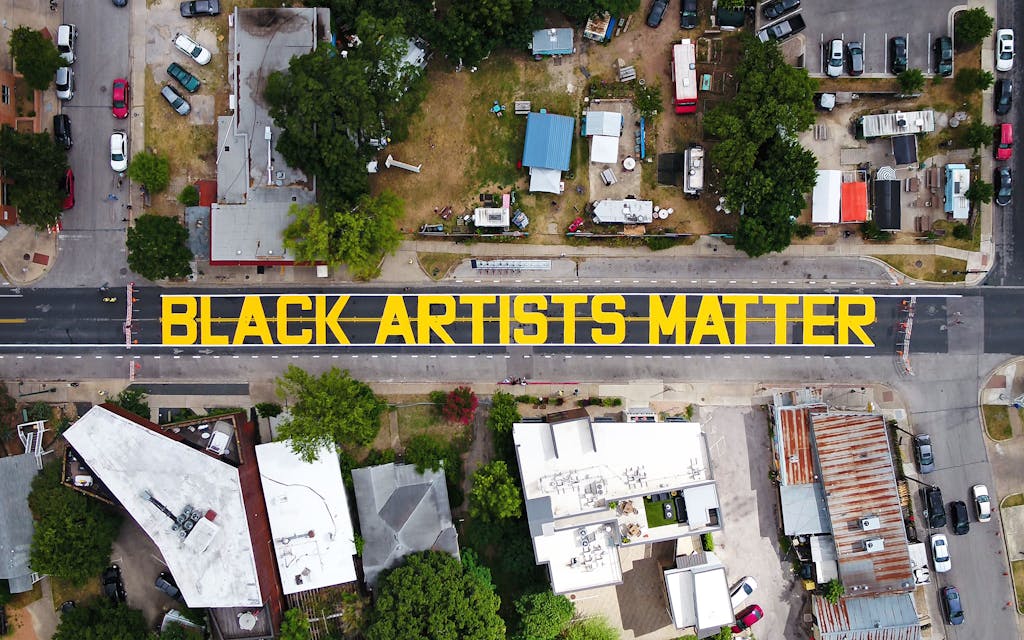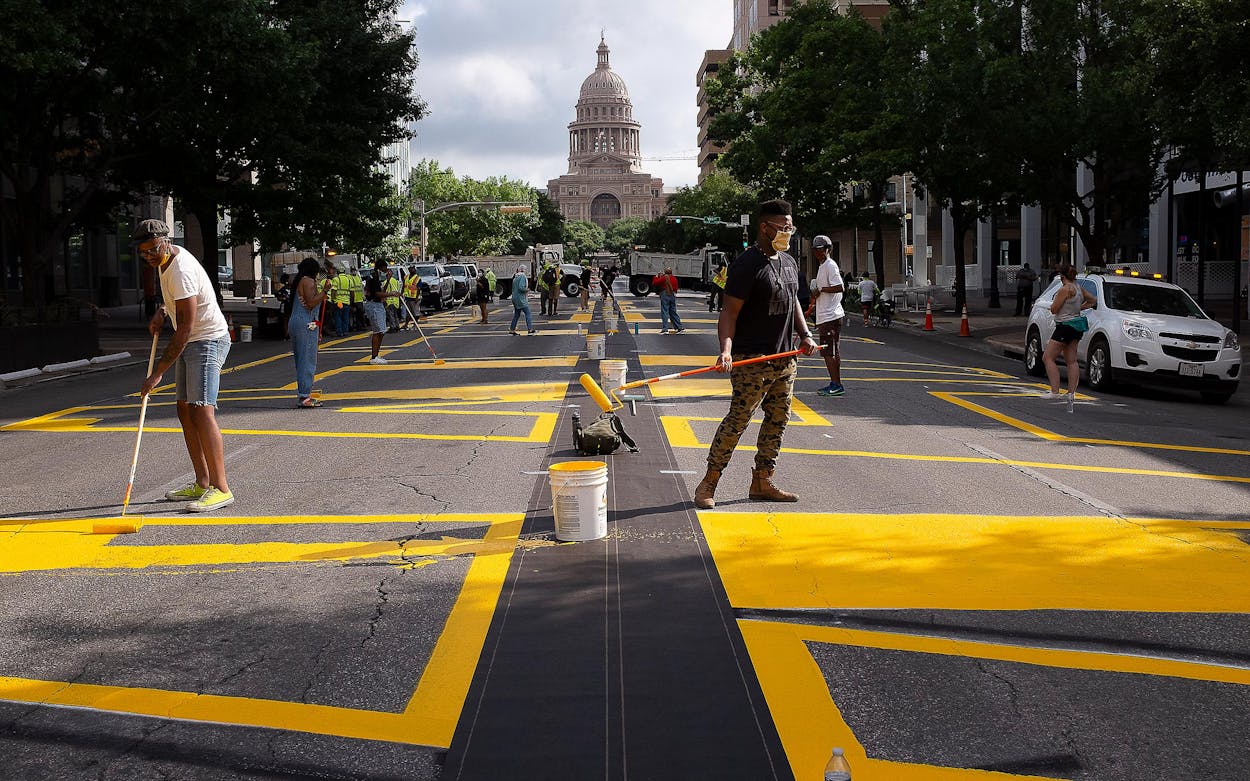On the morning of June 16, about two dozen artists and activists wearing masks and wielding long stem paint rollers gathered in downtown Austin, just a few blocks from the Capitol on Congress Avenue. Songs by Jay-Z, Burna Boy, Prince, and others played from a speaker nearby, as bystanders gathered and city employees milled about. The group, brought together by Austin Justice Coalition, a grassroots racial advocacy organization, and Capitol View Arts, a nonprofit that supports local Black and brown artists, began to paint “Black Austin Matters” in giant yellow block letters.
The street mural, along with a “Black Artists Matter” painting on East Eleventh Street, reflected weeks of protests that have spread across the country after George Floyd, a Houston native, was killed by a Minneapolis police officer who knelt on his neck for nearly nine minutes. Painters across the country have made “Black Lives Matter” street murals—first in Washington, D.C., where Mayor Muriel Bowser came up with the idea for the art with her staff and renamed a square “Black Lives Matter Plaza”—and then in cities from New York to Oakland. Some activist groups, including Black Lives Matter DC, have called these artworks “lip service,” concessions offered by cities without being accompanied by meaningful reforms. Just a few weeks after “Black Lives Matter” was painted on the street in D.C., residents began posting videos of police officers using flashbang grenades, pepper spray, and bikes to try to clear out protesters. In some of the videos, shot in Black Lives Matter Plaza, you can see parts of the bright yellow paint spelling out “Black Lives Matter” underneath the chaos.
When I first saw the mural on Congress, I felt the same skepticism I’d felt when I saw reports of the street murals elsewhere. Protesters were hitting the streets and risking possible COVID-19 infections to demand a drastic reimagining of the entire justice system—and what were we getting in response? Street paintings. It felt like an empty gesture, especially because I knew the city. And Austin didn’t feel to me like a place where Black people mattered.
For more than two decades, Austin’s Black population, relative to the whole, has been in decline. From 2000 to 2010, Austin was the only one of the nation’s ten fastest growing cities to have a shrinking Black population, according to census data. And the city’s police department has an extensive record, confirmed by the city council’s own investigations, of discriminatory policing, brutality, and racism. At the protests that inspired the murals, Austinites marched not just for victims of police killings around the country but also for those in their city. In 2016, the naked and unarmed seventeen-year-old David Joseph was killed by an APD officer, who was subsequently fired but not indicted. In April, Mike Ramos, an unarmed Black and Hispanic man, was shot by police officers with a beanbag round when he had his hands up, then was subsequently shot and killed by a firearm as he drove away from them. (The officers have been reassigned to desk duty, and a grand jury will take up the case on August 11.)
Speaking with the Black artists and activists behind the murals, though, alleviated some of my skepticism. It’s clear they also agree that the City of Austin can’t say “Black Austin Matters,” given its track record. But that’s a declaration the activists say they can make. They’ve been involved in civil rights advocacy, from organizing demonstrations to challenging APD’s union contract and calling for the resignation of police chief Brian Manley. The murals, they say, are both a way for Black Austinites to proclaim their importance to a city that has overlooked them and a call to action for city officials. The months ahead will show if the city answers that call.

In 1928, Austin’s master plan forced Black residents into the east side of town and separated them from white Austinites on the other side of what would, by 1967, become Interstate 35. In the twenty-first century, as the east side of Austin has rapidly gentrified and rents have risen, historically Black and brown neighborhoods that the city forced into existence nearly a century ago are being lost. Those that remain are almost entirely still east of I-35.
During recent protests over the police killings of George Floyd, Breonna Taylor in Louisville, and too many others, protesters in Austin have climbed onto the highway and momentarily shut down traffic on it. APD used pepper spray and fired “less lethal” rounds—“beanbag” bullets—into crowds gathered there. One officer shot sixteen-year-old Levi Ayala, a bystander, with a round that embedded into his forehead, damaged his prefrontal cortex, and required seven hours of surgery to remove. Nearby, APD also shot Saraneka “Nemo” Martin, a pregnant Black woman, in the abdomen and back, and fired beanbag rounds at Justin Howell, a Black Texas State University student, who was hit in the head, spent weeks in critical condition in the ICU, and is suffering brain damage. In early June, the Austin City Council convened a virtual meeting, with Manley, on policing at the protests.
Around the same time, Clifford Gillard, cofounder and board president of Capitol View Arts, who had seen the Black Lives Matter mural in D.C., reached out to Austin Justice Coalition to create street art for the city in advance of Juneteenth. After hearing from residents and local organizations including AJC and Capitol View Arts, Mayor Steve Adler concluded that such works shouldn’t be led by the city itself, as they had been in D.C.
“I think the community was moving forward with the concept, probably almost regardless of what the city said, so I just thought it was important for the city to do everything it could to help facilitate that,” said Adler.
Chas Moore, the executive director of Austin Justice Coalition, insisted on the phrase “Black Austin Matters” rather than “Black Lives Matter,” as had been painted in other cities. According to him, Austin needs to address its own issues with racism before even thinking of joining the national conversation. “I don’t think city officials have the privilege or the space to say, ‘Black Lives Matter,’ if we live in a city where the Black population is steady in decline,” Moore said. “You can’t just skip to ‘Black Lives Matter’ if the Black people in your own backyard are suffering the way they are.”
A “Black Artists Matter” street mural, proposed for East Eleventh, in front of the Victory Grill, a historic music venue that was part of the Chitlin’ Circuit, is a nod to the artists old and new who’ve helped make East Austin a cultural touchstone. For Samara Barks, a multidisciplinary artist who helped paint both street murals, the artwork is an acknowledgement of the role that artists—such as Langston Hughes and Nina Simone—have played in documenting and joining social movements. “The people who spearheaded and marched along with the great civil rights leaders were artists,” Barks said. “Art goes hand in hand with social change and movements.”
The city government approved both of the murals and agreed on a budget of around $60,000 that included paying the two dozen Black artists who signed up to participate at a rate of $50 an hour. The plan is that the street installations will be up for six months.
Barks is critical of other murals, particularly the one in D.C., which was initiated by city officials who she says have failed to match their policies with the words in the murals. “That’s when people have a problem with it. That’s when I have a problem with it,” said Barks. “But they weren’t the ones that painted it. We did. We are Black Austin … So that’s why I took cause with people saying that it was performative or lip service, because it wasn’t. Not for us.”
Gillard says that since 2011, when he cofounded Capitol View Arts, this mural project marked the first time he has heard the kind of response that he’s wanted from the city government. But he also wants the leaders to “tackle the hard conversations and I expect the same kind of response when we talk about them.”
Adler seems to agree. “The murals are not the movement, nor are they the action,” he told me. “And if all that happens is murals, then we will have failed this moment.”
When asked about his record making Austin a more equitable place that lives up to the mural, Adler mentioned that, during his tenure, the city has increased living wage to $15, prohibited employers from asking about an applicant’s prior criminal convictions until late in the hiring process, and created a Task Force on Institutional Racism and Systemic Inequities, which has proposed alternatives to jail for those convicted of Class C misdemeanors such as speeding and disorderly conduct. Adler notes that “none of those things … cumulatively have added up to what I believe is possible right now.”
In a conversation with Adler on June 1, Moore said that the task force was a “valiant effort,” but that the city still has a long way to go before it proves that Black Austinites matter.
In June, the Austin City Council banned chokeholds and the use of tear gas and munitions such as beanbag rounds on protesters. Afterward, the Austin police union president warned that if the bans were not rolled back, he would tell police officers not to work at protests. On June 27, after activists projected a slideshow of APD’s brutality on the side of the police headquarters, APD arrested a man for allegedly throwing a scooter at a police horse and hitting an officer with a skateboard. In the video of his arrest, four officers are holding the man down and one of them can be seen punching him.
Adler says he supports diverting funding from the police to other social services—including mental health care—but does not agree with the call for the full defunding of the police. On July 13, city manager Spencer Cronk presented his budget proposal for the 2021 fiscal year. The plan includes a “reallocation of $11.3 million” from APD to “fund alternative public safety strategies,” although in actuality $3.2 million of those funds will be redirected within the department to replace APD’s record management system and fund racial and cultural sensitivity trainings. This isn’t near the $100 million that AJC thinks should be cut from APD’s budget.
After six months, Moore says Austin Justice Coalition and Capitol View Arts will check in with community members to see whether they want the murals up longer. But he doesn’t want the physical murals to distract from their messages. “If the community comes around and they start loving it? OK, then let’s keep this thing going,” Moore said. “But I think what’s more important is that we make these statements come true.”
- More About:
- Black Lives Matter
- Austin








